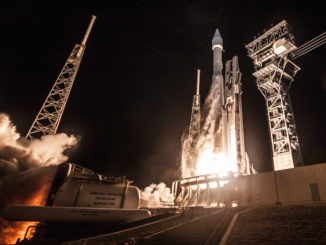Video credit: Russian Ministry of Defense
Russia launched a fresh satellite for the Glonass network Wednesday aboard a Soyuz rocket, replenishing a fleet of positioning and timing stations used around the world for navigation services.
The Glonass M navigation satellite lifted off on top of a Soyuz-2.1b booster at 0854 GMT (3:54 a.m. EST) from Pad 3 at Site 43 at the Plesetsk Cosmodrome, a military-run spaceport around 500 miles (800 kilometers) north of Moscow.
Wednesday’s launch marked the first rocket flight to originate from Pad 3 at Site 43 since a Soyuz booster crashed moments after liftoff in October 2002, killing a Russian soldier and injuring eight others. The crash partially destroyed the Soyuz launch pad, and all Soyuz flights from Plesetsk since 2002 have blasted off from a neighboring facility.
Russian teams repaired and upgraded the damaged launch pad before resuming launch operations there Wednesday.
Launched under the supervision of Russian troops, the Soyuz took off Wednesday at 11:54 a.m. Moscow time powered by kerosene-fueled engines. The rocket shed its spent strap-on boosters and payload shroud, then shut down its core stage nearly five minutes into the mission.
An RD-0124 engine on the Soyuz third stage ignited to propel the Glonass M spacecraft and a Fregat upper stage toward orbit, then released the Fregat to perform three engine firings. After the final Fregat burn, the rocket deployed the Glonass M spacecraft around three-and-a-half hours after liftoff.
The Russian Ministry of Defense said in a statement that the Glonass satellite was deployed in the targeted orbit, and was operating normally after Wednesday’s launch.
The Glonass satellite was released in a near-circular orbit at an altitude of more than 11,900 miles (19,100 kilometers) and an inclination of 64.8 degrees, according to publicly-released U.S. military tracking data.
ISS Reshetnev, a satellite manufacturer based in Zheleznogorsk, Russia, built the Glonass M spacecraft. The Russian Ministry of Defense was expected to name the Glonass satellite Kosmos 2544, keeping with the naming scheme for Russian military spacecraft.
Designed for a seven-year lifetime, the 3,100-pound (1,400-kilogram) Glonass M satellite launched Wednesday, designated No. 59, will replace an aging navigation craft in the Glonass fleet.
The Glonass satellites are spread in three orbital planes, or pathways, around Earth, each with eight spacecraft.
Russia’s Glonass fleet is similar to the U.S. Air Force’s Global Positioning System, providing worldwide navigation and timing services.
Email the author.
Follow Stephen Clark on Twitter: @StephenClark1.



